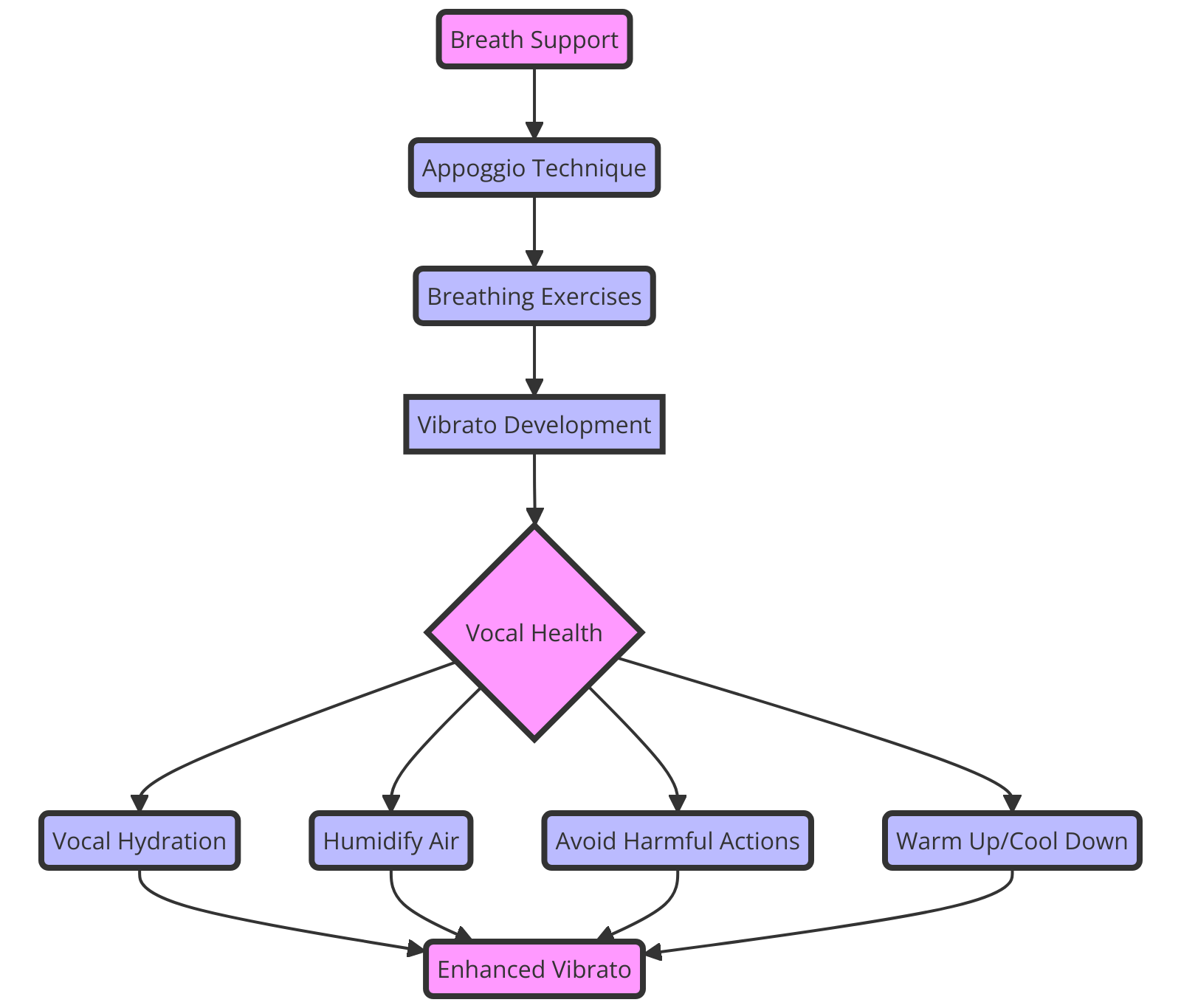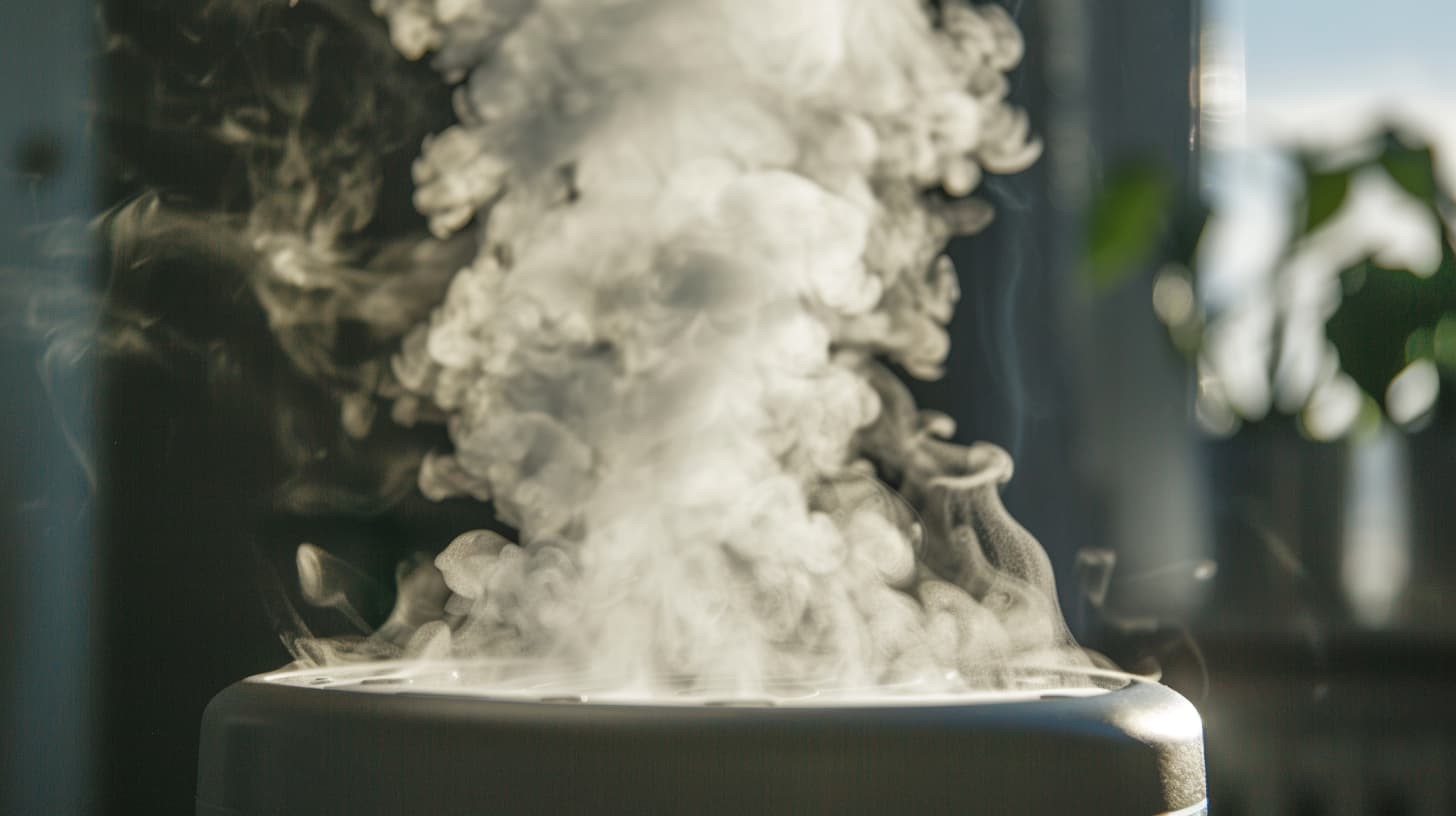Developing Vocal Vibrato Through Proper Breath Support

Boost your vocal vibrato through proper breath support techniques. This quick guide teaches singers how to develop beautiful, lyrical oscillation.
Have you ever listened to a singer with a rich, soulful voice? It seems to flow. Chances are they had a well-developed vocal vibrato. Vibrato is the pulsing or wavering sound. It happens in the voice when the vocal cords are free of tension. It creates warmth, resonance, and an emotional connection for listeners. Many singers want to develop a pleasing vibrato. But, they don’t always know the technique for it.
The key to an engaging vocal vibrato is proper breath support. You get it by understanding and developing it. Breath support provides the underlying foundation for freeing the voice to fully resonate. When singers learn to breathe in and out, vibrato emerges. It does so without the need for artificial manipulation. By working on breath support, singers give themselves a gift. It lets them express emotion and connect with listeners using their natural vibrato.
| Key Concepts | Techniques to Try | Common Mistakes to Avoid |
|---|---|---|
| Appoggio breath support | Pursed lip exhales, sustained humming | Shallow chest breathing, holding breath |
| Vocal cord freedom and flexibility | Straw phonation, lip trills | Artificially manufacturing vibrato |
| Consistent practice and patience | Expanding rib cage, engaging lower abs | Tensing neck, jaw, and throat muscles |
What Exactly Is Vocal Vibrato?

Before diving into breath support, let’s clarify the characteristics of vibrato itself. , vibrato occurs when the vocal cords oscillate. They do so between higher and lower pitches. This rapid variation creates the wavering sound of vibrato. The pulses happen between 5-8 times per second.
- True vibrato differs from tremolo in a couple of key ways:
- It is faster, with a wider and more regular pulsation rate
- It involves variation in pitch rather than volume
- When done, vibrato creates warmth and resonance without sounding artificial or trilling
- It allows singers to express emotion through lyrics
- Creates an intimate connection with the listener
Many singers want to develop vibrato. It impacts the listening experience when done well. It adds beauty and lyricism to the voice in a way nothing else can.
But what exactly causes that wavering variation in pitch? The oscillation comes from breath pressure and the larynx muscles. They adjust the pitch up and down. This requires complex coordination. When the singer lacks freedom in both breath and larynx, their ability to vary is limited. This prevents vibrato.
Why Do Some Singers Have More Vibrato?
Vibrato production involves intrinsic musculature that can vary from person to person. Some singers may have:
- Longer, thicker vocal cords
- Increased mucosal wave activity on vocal cords
- More elasticity in larynx muscles
- Greater breath pressure variations
These factors make it easier for some people’s voices to quickly change pitch. Their intrinsic vibrato turns “on” more. Thinner, shorter, or stiffer vocal cords can restrict oscillation.
The good news is that vibrato can always improve with good technique. This is especially true for those who lack an inborn talent. Anatomy plays a role. But, it does not stop you from developing a beautiful, expressive vibrato.
Why Breath Support Matters

So if vibrato depends on lack of vocal tension, where does breath support come in? Good breath support is crucial. It provides the needed airflow control. This keeps pitch and volume while singing without adding tension. Good technique prevents singers from straining the voice or faking the larynx. They do this to make their voices heard.
Without adequate breath support, singers often experience:
- Quick loss of volume and projection
- Pitch instability
- Lack of vocal stamina
- Excess physical tension
- Inability to complete longer phrases
All these issues inhibit freedom of vocal fold oscillation. When singers tense up, chase pitches, or run out of air too, they can’t get easy, resonant vibrato.
The bottom line? Breath support provides control and stability. It lets the voice resonate on pitches and vowels without closing.
Learning Appoggio Breath Support Technique

So what exactly IS efficient breath support for singing? The gold standard is a support technique called appoggio. It comes from the classical Italian school of singing.
In appoggio, breathe in. Then, breathe out to keep pitch and resonance. Expanding the torso and using specific muscles do this.
Here are the key elements of developing appoggio breath support:
Postural Alignment
Good posture allows most expansion and control. Stand or sit tall, with shoulders back and centered over hips. Avoid slouching.
Rib Expansion
Inhale by allowing the lower ribs to expand out to the sides. Feel expansion all-around your rib cage.
Engage Lower Abdominals
As you exhale to sing, gently draw your lower abs in and up to provide stability and resistance.
Avoid Shoulder Tension
Consciously keep shoulders relaxed down. Extra tension reduces rib expansion and breath capacity.
Take Full Inhalations
Don’t “sip” tiny quick breaths. Inhale fully to utilize your full lung capacity and maximize breath support.
Practice Breath Control Exercises
Getting comfortable with appoggio takes time and consistency. Try hard exercises. These include sipping through a straw and sustained humming. They help you coordinate breathing in and out.
As you develop awareness of appoggio breath support, you can then…

Apply Breath Support Technique to Enhance Vibrato
The payoff for all that breath support practice comes when you apply it to singing. Here are some tips:
- Inhale before starting each phrase
- Maintain support on longer, sustained pitches
- Allow vibrato to emerge without larynx manipulation
- Use proper support to complete phrases without sudden unwanted scooping/sliding between pitches
The key is letting appoggio breath support work for you as you sing. Trust your breath and keep the airflow steady. As long as you keep tension-free, vibrato will follow.
The great news is that you can always improve your breath support technique. You can do this even if it feels unfamiliar at first. Stay patient through the process and don’t forget to incorporate helpful exercises. You’ll discover newfound freedom and stamina in your voice with consistent practice.
Before you know it, you’ll be wowing listeners. You’ll do it with your expressive, vibrant vocal vibrato!
Key Takeaways on Enhancing Vibrato Through Breath Support
- Vibrato occurs when the vocal folds oscillate, creating resonance
- Proper breath support provides the controlled airflow needed to enhance free vibration
- Appoggio breath support relies on rib expansion and engaged lower abdominals
- Support stabilizes pitch, volume, and vocal stamina so vibrato emerges
- Practicing support separates the singing technique from larynx manipulation
- Patience and helpful exercises allow support skills to improve
Focus first on developing excellent appoggio breath support techniques in your singing. With time and consistency, your natural vibrato will flourish!
As your skills improve, remember to redo breathing exercises. Do them when you feel tension returning. Solid support is the foundation. It helps you find the beauty and freedom in your voice.
Common Breath Support Mistakes That Restrict Vibrato

Appoggio is the ideal. However, many singers keep less efficient breathing habits. These habits undermine support. Here are some common mistakes and how to fix them:
1. Shallow Chest Breathing
- Causes: Habit, tension, poor posture, small inhales
- Fix: Inhale into lower ribs first, then let chest follow
2. Tipping or Arching Lower Back
- Causes: Trying to expand ribcage, but overarching lower spine
- Fix: Keep lower back neutral, focus expansion in ribs
3. Raising Shoulders While Inhaling
- Causes: Habit, lack of rib expansion awareness, tension
- Fix: keep shoulders low and relaxed during inhales
4. Holding Breath
- Causes: Fear of losing support/control, poor coordination
- Fix: Continue flowing breath, don’t hesitate to inhale/exhale
The key is staying mindful of posture and specific muscle engagement. It takes time to override poor breathing habits. Be patient and keep troubleshooting with targeted support exercises.
Developing Appoggio Breath Support Through Helpful Exercises

While understanding appoggio is vital. But, training the intercostal muscles and abdominals. Tailored exercises achieve this. It speeds up skill development. Here are 5 great drills:
1. Pursed Lip Exhales
- What: Pucker lips in an “O” shape, exhale through the small opening
- Benefits: Builds control, smoothness, and resistance
2. Sustained Humming
- What: Inhale, hum a pitch for as long as possible
- Benefits: Links breath support to tone production

3. Yoga Breath of Fire
- What: Short, rapid inhale/exhale cycles using lower abs
- Benefits: Stamina, breath/muscle coordination
4. Hands-on Ribs
- What: Place hands on the rib cage, focus on expanding ribs sideways on inhaling
- Benefits: Kinesthetic feedback for lower rib expansion
5. Suspended Sipping
- What: Sip water through a straw held above the water’s surface
- Benefits: Maintain resistance and airflow consistency

Start with 2-3 minutes per exercise, building to 10+ minutes for greater endurance. Daily practice leads to the most rapid mastery. Record yourself to check for visible expansion patterns.
What other creative exercises help you develop breath support skills? Share your ideas below!
Optimizing Vocal Health and Larynx Freedom for Enhanced Vibrato

Breath support is important. But, to have an easy vibrato, the larynx and vocal cords must also be healthy and flexible. Here are some key optimization tips:
Hydrate, Hydrate, Hydrate
- Thin vocal cord tissues must lots of hydration to keep elasticity
- Aim for at least 64 oz. of water daily, more if active
- Avoid drying irritants like caffeine, alcohol, and antihistamines

Humidify Air
- Dry air causes fluid loss and stiffness in vocal tissues
- Use a humidifier, especially in bedrooms and practice spaces
- Breathe through your nose as much as possible

Avoid Throat Clearing/Coughing
- Aggressive actions create inflammation and tiny tears
- Sip water or do gentle lip trills instead if needed to clear
Warm Up
- Cold, unprepared vocal cords don’t oscillate as
- Start practice with gentle humming, and lip trills in mid-range
- Once you warm up the cords, expand the range.
Cool Down
- ending practice causes blood pooling, swelling
- Finish with mid-range exercises at lower volumes
- Don’t talk much afterward, let cords rest
Supplements
- Gelatin, licorice root, and slippery elm soothe and coat tissues
- Probiotics balance gut flora, reducing reflux irritation
- Vitamins A, C, and E improve tissue resilience and healing
minimizing vocal fatigue, dehydration, and inflammation helps. It leaves cords able to vibrate. Support healthy flexibility through smart vocal care choices!
What other wellness tips help you enhance larynx health as a singer? Share your ideas below!
How Breath Support and Vibrato Link to Developing Vocal Power

As singers advance, better breath support and vibrato pave the way for true vocal power. But what defines vocal power?
Vocal power comes from breath energy. It also comes from well-supported resonance, clear diction, and emotional connection.
Without proper appoggio breath support, singers often over-engage their larynx muscles. They do this to compensate for the lack of air pressure and volume. This excessive squeezing precludes freedom of vibration.
Good support allows more energy to flow through the vocal cords. It does this without closing down the space for resonance. The cords can oscillate and vibrate.
As vibrato emerges, singers can push strong breath into the pharynx, mouth, and sinuses. These are rich spaces. This amplification produces huge, ringing tones without strain.
In short, breath support and healthy vibrato are the foundation. They are key for belting and mixing. They provide real power and stamina. The stronger the support system, the more potential expansion a voice can achieve!
Troubleshooting Breathy, Airy Tone Due to Excess Breath Flow
Lack of breath support often hinders vibrato. But, too much breath can also cause problems. Too much air pressure through the vocal cords makes the tone breathy and unfocused.
Too much air through the folds stops them from closing. It also stops them from vibrating between pitches. This air leak gives the tone an unfocused, blustery quality lacking a harmonic ring.
Here’s how to troubleshoot breath issues causing breathy tone:
1. Assess Support Technique
- Ensure ribs and abdominals manage air pressure
- Avoid collapsing posture or dropping breath engagement
2. Scale Back Airflow
- Don’t push air, instead allow gentle release
- Imagine guiding, not driving, breathing through vocal cords
3. Check Larynx Position
- If the larynx rises or tilts, vibrato space gets restricted
- Keep larynx neutral using breath support
4. Watch Cord Closure
- Using a mirror, check that cords close on consonant attacks
- Plosives like “p” or “t” need quick compression
5. Strengthen Cord Closure
- Incorporate staccato exercises to develop compression
- Use “t” or “k” attacks, short phrases with quick release
Stay patient correcting excess breath support. Reigning in too much air pressure is hard. But, it’s very trainable with practice while keeping freedom!
What other solutions help you balance air flow and cord closure? Share your ideas below!
Why Some Singers Artificially Manufacture Vibrato

Breath support and larynx flexibility enable natural vibrato. So, why do some singers create vibrato?
People make vibrato because they lack training. They also do it due to poor instruction, peer pressure, and bad performance goals.
Without a proper technical foundation, singers may start manipulating their larynx. They do this to produce ANY type of oscillation. Common physical manipulations include:
- rolling tongue back towards the pharynx
- Pulsating diaphragm/abdomen
- Tensing/relaxing throat muscles
- shaking head/jaw
- Variating air pressure through squeezed vocal cords
These physical tricks produce an artificial wavering, but NOT a true vocal vibrato. The tone often sounds tremulous, wobbly, or bleating instead of lyrically pulsating.
Manufactured vibratos engage muscles better left relaxed for ideal resonance. This leads to increased vocal fatigue and a lack of tonal consistency.
Plus, singers lose out on vibrato’s natural therapeutic benefits! Easy oscillation massages and stretches the vocal cords, keeping them healthy.
So, it’s tempting to mimic vibrato in any way possible. But, nothing beats its organic emergence from excellent technique!
How Actors Emulate Healthy or Unhealthy Vibrato

Actors aiming for vocal authenticity work hard. They try to capture a character’s likely vibrato or lack of it.
Reasons characters might have excellent or poor vibrato include:
- Level of vocal training
- health and lifestyle habits
- Genetic predispositions
- Personality and emotional expressiveness
- Confidence as a singer or public speaker
Here’s how actors create the illusion of amazing or weak vibratos. They do it :
Performer with Solid Vibrato
- Use appoggio breath support for pitch stability
- Allow larynx full freedom without tension
- Open resonating spaces for ring
- Add personal emotion/vulnerability
Poor Vibrato or Straight Tone
- Tense tongue, throat, shoulders, abdomen
- Limit breath support
- Restrict resonating space
- Sing /disconnected from lyrics
Of course, emulating vocal strain requires careful technique adjustments. Actors want to avoid damaging their voices while portraying limitations!
The key is to create the illusion of restriction or freedom. But, you must do this while keeping personal ties healthy. Excellent vocal control makes this possible.
For example, actors use a resonant twang or tongue arch. They use them to mimic larynx tension without actually squeezing. It’s vocal magic!
What other ways have you heard actors manipulate their voices? Share your insights below!
Developing Vibrato and Support in Young Singers

Many parents and teachers wonder: “At what age can kids start using vibrato? It requires better breath support.” Here are some age-specific considerations:
Early Elementary (ages 5-7)
- Focus on playful vocal exploration, avoiding tension
- Incorporate movement linked to long tones
- Encourage imitation of healthy modeling
Older Elementary (ages 8-10)
- Introduce awareness of lower rib expansion
- Teach sipping, humming, lip trills
- Start very gentle appoggio concepts
Middle School (ages 11-14)
- instruct appoggio breath support
- Troubleshoot jaw, tongue, neck tension
- Incorporate more advanced breathing exercises
- Encourage self-assessment and self-correction
- Introduce the concept of vocal registers and transitions
High School (ages 14-18)
- Refine appoggio technique with advanced exercises
- Focus on developing consistency and stamina
- Encourage exploration of different musical styles and emotions
- Address any individual vocal challenges or tension issues
- Emphasize the importance of vocal health and proper care
College and Beyond
- Continue refining breath support and vibrato techniques
- Encourage experimentation with different genres and languages
- Focus on developing a unique artistic voice and interpretive skills
- Address any persistent technical issues with targeted exercises
- Emphasize the importance of lifelong learning and growth
Every singer develops at their own pace. So, these age ranges are guidelines. Some children may be ready for advanced techniques earlier. Others may need more time to develop the needed skills.
The key is always to rank healthy vocal production. And, to avoid pushing young singers too hard too soon. Young singers can develop breath support and vibrato skills. They need these skills to express themselves in music. They will do this with consistent, age-appropriate instruction and plenty of patience.
Conclusion
Developing a lovely vocal vibrato is a journey. It starts with mastering proper breath support. By learning the appoggio technique and using it through practice and exercises. Singers can build a stable foundation. It lets their vocal cords to oscillate. Patience, vocal health, and avoiding faking are key. They help achieve a strong, moving vibrato that captivates listeners. With dedication and the right approach, any singer can unlock their voice’s full potential.
Frequently Asked Questions
What is vocal vibrato?
Vocal vibrato is the natural pulsation or wavering sound. It happens when the vocal cords go between higher and lower pitches. This usually happens 5-8 times per second.
How does proper breath support enhance vibrato?
The vocal technique known as “appoggio” requires efficient breath support.” It provides the controlled breathing needed to sustain pitch, volume, and resonance. It does this without adding extra vocal tension. This stability allows the larynx and vocal cords to oscillate.
What happens without proper breath support?
Singers tense up due to not enough breath support. This leads to poor pitch control, lack of stamina, and inability to complete long phrases. This vocal constriction inhibits healthy vibrato.
What are the key elements of appoggio breath support?
Appoggio relies on good posture. It allows the lower ribs to expand when inhaling and the lower abs to engage when exhaling. It avoids shoulder tension and requires full breaths and tough breath control exercises.
How do you apply breath support to enhance vibrato?
Singers need to breathe before phrases. They need to keep steady breaths on long notes. They must avoid moving larynx muscles. They should use their breath to slide between pitches. They should not use it to make sudden, uncontrolled slides and scoops.
Can someone with poor natural vibrato still improve?
Yes! Anatomy plays a role. But, good vibrato relies more on solid vocal technique. This is especially true for breath support. So, even those without an inborn predisposition can improve. They can do so with practice.
What are some dangers of manufacturing vibrato?
Making vibrato comes from moving larynx muscles. It does not come from using breath support. Doing so leads to vocal strain. It also causes diminished tone, pitch control problems, and reduced stamina. It harms vocal cords over time.


